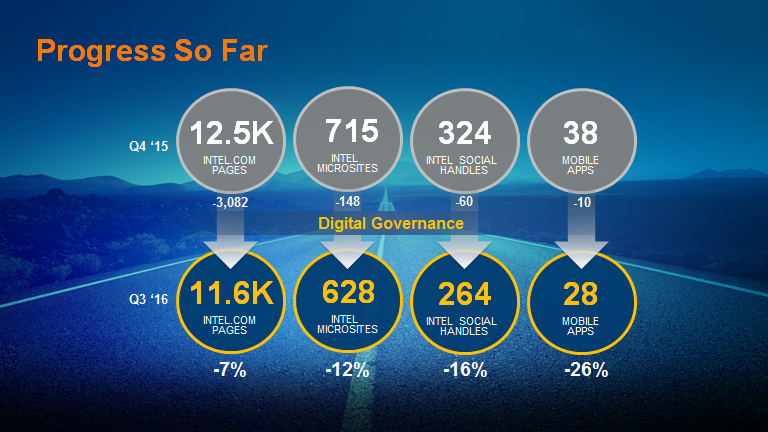
Many organizations today are facing similar challenges around consistent execution of a digital strategy, delivering connected user experiences, and fully leveraging a crowded but robust set of available marketing technologies. Intel has implemented a strong digital governance operational framework to address these challenges and help the company transform its business. I appreciate the opportunity to share what I think digital governance is and why I think every organization should have it.
In 2016, Intel has been focused on refining its digital governance framework, starting with an initiative to evaluate its existing digital footprint, both at a channel and content level. Intel started with a major effort to define clear criteria for evaluating content, which resulted in a significant content reduction. This formed the building blocks for Intel to effectively govern its digital experiences going forward.
While the content reduction effort has demonstrated initial success, efforts to further reduce content based on clear standards and guidelines continue. The above graphic shows where Intel started late last year, the amount of content reduced in 2016 through the governance criteria, and the net digital footprint taking into consideration development of new content, aligned to Intel’s governance standards. By starting with a content reduction initiative, Intel was able to accelerate the broad implementation of its governance framework across the company. In moving consultation around strategy, capabilities, and governance upstream in the launch process, we moved from 80% of governance engagements occurring after development to 60% occurring before development—huge progress in a short period.
Getting Started
I’ve been with Intel for 11 years now, but a little over three years ago, I assumed leadership of operations for our digital marketing organization. At the time, we were a small team focused on operations: budget management, process improvements, and training. But we also had one person focused on this thing called “governance,” which at the time meant ensuring necessary reviews of digital properties (websites, domain names, and mobile apps) were happening with our brand, privacy, legal, and IT teams. It wasn’t too surprising that we had such a function given Intel’s major focus on protecting our brand as a globally recognized and trusted company.
As my integration into the role progressed, we realized that we actually had a unique opportunity to influence marketing execution beyond just risk mitigation given our centralized oversight role and our digital expertise; however, we were engaged way too late in the execution lifecycle to have any meaningful impact. It was then that we went on a mission to move upstream in our engagement with marketing stakeholders and implement an operating model that would not only oversee how Intel does digital but also drive strategic value for marketing.
On one Sunday afternoon, I took a leap of faith and searched online for the term “digital governance” to see who else was approaching managing digital in a similar way. I came across Lisa Welchman, whose work really resonated with me. Her approach to digital governance’s role as enabling and overseeing execution of digital marketing was exactly what I was looking for … and it was at that moment that I realized our team needed to not just embrace digital governance, but evangelize it. We believed in it so much that we shortly thereafter changed our team’s name to Digital Governance and Operations.
My career has been focused on business operations and, in particular, designing and implementing systems and processes that enable organizations to achieve their business objectives. I’ve always been interested in creating order where there’s disorder, whether it is in a start-up type organization or a large enterprise like Intel and Microsoft. In our approach to digital governance, we have implemented exactly that—introducing structure in a world full of dynamic and disruptive opportunities and challenges. And while our governance model is not a new concept (in fact, there are many parallels to supply chain management principles), it is quite revolutionary in the marketing world. Our key to success has been to constantly align and demonstrate the business value of our digital governance framework to our marketing partners, and we’ve been able to do that by focusing on these six concepts.
1. Reducing Anxiety, Upping Excitement
Indeed implementing digital governance is challenging for organizations of any size or industry, but when aligned to specific business objectives, the value can be huge. From our experience, the most impactful efforts are realized when they are tied to resolving specific, imminent business challenges and those that enable business growth. The first step in your digital governance journey should be to deeply understand what it is you’re trying to address and the business impact. For example, if you are tackling content strategy issues like content bloat or what I call “experience bloat” (an abundance of websites, social handles, mobile apps, etc.), clearly define the impact to your marketing objectives and customer experience. Is it diluting your brand value? Decreasing qualified leads? Exposing internal organizational silos to your customers? Once done, share and validate your findings within your organization’s key influential stakeholders, such as your CMO and executive team. Gaining senior buy-in across the company is critical to securing the support, resources, and widespread behavioral shift needed to build a strong digital governance framework.
We immediately recognized that the term “governance” makes people cringe and naturally think of controls that prevent creativity and don’t align with a “real-time” marketing approach. From my organization’s perspective, we went through a brainstorming exercise identifying alternative words to describe what we were trying to implement—but in the end, we decided to embrace the term and do our own marketing to build a brand around governance as we defined it … after all, we are part of marketing! We defined the values we wanted our stakeholders to associate with us and focused on elements marketers care about, instead of typical risk management and process orientation approaches many operations teams might take.
We also made a conscious effort to be strategic partners in helping make amazing marketing possible, decreasing time to market, leveraging advanced marketing technologies, and protecting our valuable brand. Our team partners with marketers across the company to facilitate every digital customer experience from beginning to end to bring these values to life and make it as easy as possible for marketers to do the right thing.
Through this partnership, we have received countless recognitions from stakeholders who previously were skeptical about governance but then embraced and even applauded our positive impact. These testimonials from our stakeholders really fuel our team to embrace governance as a strategic marketing asset.
From a marketer’s perspective, we want to build a positive sentiment around governance. For those stakeholders who go above and beyond our expectations in partnering with us to adhere to our governance processes, policies, and standards, we provide formal recognition. In particular, we leverage Intel’s internal cash recognition system, call out kudos in stakeholder staff meetings, and even send recognition gifts branded with our governance slogan, “Enabling One Intel.”
So governance is only boring if you make it boring! By embracing the value enabled by strong governance and developing a culture based on positivity and collaboration, you can transform governance into something marketers cherish.
2. Better Marketing Through Governance
First of all, the emphasis on digital governance has required us to home in on our marketing strategies since governance ultimately must be focused on overseeing and enabling the execution of strategy. With the formalization of our central digital governance team, we found ourselves uniquely able to see the overall digital experience for our customers and not just specific content or websites.
We reviewed each and every external digital customer experience to ensure three factors:
- Alignment to business/product strategies and our digital strategy
- Effective use of our marketing technologies
- Adherence to our governance policies and standards covering brand, legal, privacy, and security concerns.
To facilitate this review and build broad visibility, we implemented a transparent, company-wide decision-making forum led by our Vice President for Digital Marketing, who reviewed each of these experiences against these three criteria. While it was a little rough in the beginning, after about a month of implementing our formal review process, we began noticing marketing teams within business and product divisions forming teams to govern themselves before reaching our forum—which was exactly the behavior we wanted, and frankly needed, to govern such a large, global enterprise like Intel.
Secondly, by going through a significant content reduction effort this year, we’ve established a pragmatic approach to evaluating our digital footprint, both at the account/site level as well as the page/content level. We now have a framework for deciding when we should close a social handle or a website as well as when it’s appropriate to create new ones.
3. Think Beyond ‘Rules’
Governance is not just about following rules. Effective 21st century digital governance addresses a much broader operational ecosystem. For example, if as a marketer you are working on a new, highly visible campaign, knowing which creative guardrails you should follow, channels you can publish to, and technologies you can leverage, all expedite the campaign management process by minimizing the unknowns and leveraging proven best practices.
As for addressing our content quantity issues, we focused on data. We developed multidimensional criteria for evaluating our content and channels that provided a fair, objective framework for us to have those difficult conversations. Examples of our criteria included performance/engagement metrics, long-term resourcing plans, and corporate priorities. Even though we provided a process for stakeholders to appeal our content reduction recommendations, the vast majority actually embraced our recommendations since our approach was fair, transparent, and objective.
Content creation can certainly be a very personal and emotional topic. We realized that and decided to minimize as much as possible the emotional element by identifying clear, objective criteria to evaluate content against. We’ve learned from previous efforts at governing content that were too focused on just performance data only that we needed to take a multi-dimensional approach to evaluating content. Instead, in addition to performance data, we looked at strategic alignment to corporate priorities, content ROI, and resource commitments to support. And in cases where there was a recommendation to end-of-life content, our governance team tried to understand the content owners’ strategy and objectives and guide toward existing, higher scoring content. This data-focused and collaborative approach resulted in far less escalations and emotional pleas from our stakeholders and demonstrated that we were not reducing content just to reach a target, but rather to change the culture for how we execute marketing.
4. The Key Element: One Vision
Our vision, shared across the company, was to act as “One Intel,” which we used throughout decision-making forums, governance processes, and communications. One of our most pressing challenges needing to be addressed was that our internal organizational structures were being exposed through our customers’ digital experiences. Audiences like developers and IT decision makers are common audiences targeted across Intel’s product groups. By encouraging sales and marketing to focus on delivering a “One Intel” customer experience, we were putting our audience’s needs first while at the same time recognizing the vast availability of relevant solutions across business groups. Previously, with our downstream governance engagement approach, we weren’t in a position to drive this, but as we moved upstream into a more strategic consultant role, we have been able to take advantage of our central oversight perspective and facilitate synergies among business groups.
Driving this “One Intel” approach operationally has been one of the most valued benefits of implementing our governance model and also one of the most rewarding in securing short-term wins.
5. Big Challenges = Big Wins
Our biggest challenge was establishing what we should govern and what we had the authority to govern. When we started our journey of implementing digital governance, we didn’t have a clear point of view on what our scope should be. So our first task was to analyze our current digital environment and prioritize where we could add the most value with limited resources. Then we had to gain executive buy-in to ensure a clear final decision maker was empowered to oversee digital execution. We accomplished both by actively participating in our company-wide strategic evaluation of marketing and pushing for decisive direction from our executive team.
The other huge challenge we dealt with was changing the perception people have when they think of governance. We chose to directly address concerns around adding bureaucracy, slowing execution, and decreasing our marketers’ ability to be creative by treating “governance” as a brand, raising broad awareness of how we’ve defined governance and the value enabled by its implementation. And we lived those values on a daily basis by organizing our team so that stakeholders would have a single point of contact throughout their engagement who also took a strategic, consultative approach rather than just one of an operational project coordinator. We also developed our own performance indicators to measure the success of implementing our governance framework, which included factors like number of consultations, “wins” where we saved the company money, and number of employees educated about governance.
Governance is indeed not just an operational necessity for marketing—it can and should be a strategic marketing asset. By minimizing unknowns, proliferating best practices, and streamlining team members’ roles and their responsibilities, we have been able to decrease our marketers’ time to market and focus their energy on creating outstanding customer experiences. As Intel announced earlier this year, we are undergoing a major strategic transformation across the company, requiring agility like we’ve never seen before.
Governance has been critical to enabling that agility.
With executive management support, implementing digital governance can be easier than you might imagine. When you have clearly identified the business impact of minimal or no governance and gained the backing of your executive team, you can minimize the headwinds while applying digital governance. We used a company-wide strategic evaluation of marketing at Intel to escalate our concerns and observations, and once our leadership team made a decision, within a couple of months we successfully implemented our corporate-wide digital governance framework.
We’ve learned through our interactions with other marketing teams and stakeholders that the challenges we identified early on are not unique to digital. In fact, the same opportunities to drive governance exist in traditional marketing areas, like PR, events, creative, etc. Given the success we’ve seen, our vision is to further mature our digital governance framework across Intel and extend to other areas of marketing.
6. It’s the 21st Century Way
Marketing buzzwords like “real-time marketing,” “programmatic media,” and “personalization” are all exciting focus areas that are helping marketers evolve and reach our audiences more efficiently and effectively than ever before. But as we all can acknowledge, modern marketing has never been so complex—whether it’s developing and executing omnichannel marketing activities, knowing how to appropriately leverage available marketing technologies, or using data and insights to optimize campaigns.
Governance is an enabler to great 21st century marketing. Could you imagine operating in an environment where best practices are ignored and you have to reinvent the wheel for each campaign? Or making use of only a small fraction of a marketing technology you have invested tons of money into? Or forcing your team to source, on-board, and train agency partners for each and every marketing activity? These are some of the elements digital governance is meant to address: convert best practices into documented standards, ensure proper usage of technology, and oversee the overall execution of digital across your entire team, be it your core marketing organization or extended team members like agency partners.
And when effective governance is implemented, marketers see the value. Just last week I received an unexpected thank you from one of our extended marketing stakeholders who initially assumed governance was “yet another layer of bureaucracy and another roadblock.” In his detailed email, he articulated the value in our collaborative approach, facilitating cross-organizational conversations, and ensuring best practices were followed.
His note ended with a huge thanks for “making it easier for us to achieve our business objectives.” And he’s not alone … as our governance framework evolves, recognitions like this are more and more common!
For these reasons, I do in fact strongly believe that governance enables amazing marketing experiences for our customers. Our marketers are executing faster, smarter, and seeing great results. Fundamentally, governance brings order in a world full of chaos—something every organization can benefit from.
Events, Resources, + More
New Data: Content Ops + AI
Get the latest report from the world's largest study of content operations. Benchmarks, success factors, commentary, + more!
The Ultimate Guide to End-to-End Content
Discover why + how an end-to-end approach is critical in the age of AI with this comprehensive white paper.
The Content Advantage Book
The much-anticipated third edition of the highly rated book by Colleen Jones is available at book retailers worldwide. Learn more!
20 Signs of a Content Problem in a High-Stakes Initiative
Use this white paper to diagnose the problem so you can achieve the right solution faster.







Comments
We invite you to share your perspective in a constructive way. To comment, please sign in or register. Our moderating team will review all comments and may edit them for clarity. Our team also may delete comments that are off-topic or disrespectful. All postings become the property of
Content Science Review.